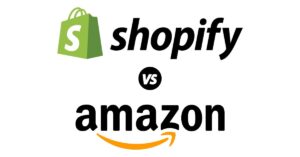Choosing between Shopify and Amazon for your online business is like deciding between creating your own boutique or setting up shop in a bustling marketplace. Both options offer distinct paths to success, but the journey and experience differ significantly.
This guide explores the features, benefits, and challenges of both platforms, helping you decide which one aligns with your business goals and vision.
Shopify and Amazon Quick Comparison
Platform Type
Shopify: A standalone, fully customizable online store that gives you total control over design, features, and branding.
Amazon: A massive online marketplace with built-in traffic and infrastructure — ideal for quick visibility but with limited customization.
Pricing (as of this article)
Shopify: Starts at $39/month USD (Basic), with higher plans at $105/month (Shopify) and $399/month (Advanced).
Amazon: Individual Seller: $0.99 per sale. Professional Seller: $39.99/month.
Transaction Fees
Shopify: 2.9% + 30¢ per transaction on the Basic plan. No extra fees if using Shopify Payments.
Amazon: Referral fees range from 8% to 15%, depending on the product category.
Customization
Shopify: Full design freedom with thousands of apps and themes for a tailored store experience.
Amazon: Limited customization — listings follow Amazon’s standard template.
Customer Ownership
Shopify: You get full access to customer data, enabling direct marketing and stronger relationships.
Amazon: Amazon controls the customer data, restricting direct communication with buyers.
Traffic Generation
Shopify: You need to drive your own traffic via SEO, ads, or social media.
Amazon: Built-in customer traffic from millions of daily shoppers — great for exposure.
Fulfillment
Shopify: Offers third-party fulfillment, including Shopify’s own service — but sellers typically manage logistics.
Amazon: Fulfillment by Amazon (FBA) handles storage, packing, shipping, and even customer service.
Branding
Shopify: Full control over your branding, store layout, and customer experience.
Amazon: Limited branding opportunities, though Brand Registry provides some customization.
Sales Channels
Shopify: Sell on your website, social media platforms, marketplaces, or in person with Shopify POS.
Amazon: Primarily limited to Amazon’s marketplace, though some brand features offer slight flexibility.
Customer Support
Shopify: 24/7 support via chat, phone, and email — plus access to Shopify Academy and community forums.
Amazon: Amazon manages customer service for FBA orders. Sellers handle reviews and messages for other sales.
Ideal For
Shopify: Entrepreneurs who want full control over branding, customer data, and store experience.
Amazon: Sellers who want immediate access to a large audience and simplified logistics.
Pros and Cons of Shopify & Amazon
Shopify Pros and Cons
| Pros | Cons |
| Easy to use: Shopify offers an intuitive interface, making it simple for beginners to set up an online store without coding skills. | Ongoing costs: Monthly subscription fees range from $39 to $399, plus additional costs for apps and themes. |
| Customizable store: Extensive customization options with 150+ themes and over 8,000 apps available to enhance store functionality. | Transaction fees: Shopify charges extra transaction fees (0.5% to 2%) if you use payment gateways other than Shopify Payments. |
| Built-in SEO and marketing tools: Shopify offers robust SEO features and integrations for email and social media marketing, which can help drive traffic. | Limited free themes: Only a small selection of free themes (12), with premium themes costing up to $350. |
| Scalable: Suitable for businesses of all sizes, from small startups to large enterprises, with advanced plans for growth. | Customization limitations: More complex customizations may require knowledge of Shopify’s proprietary Liquid language, making it harder for non-developers. |
| Excellent support: 24/7 customer support via chat, email, and phone, plus access to educational resources like Shopify Academy. | Expensive apps: Adding essential apps for enhanced functionality (e.g., advanced shipping or marketing) can significantly increase monthly costs. |
| Omnichannel selling: Shopify allows you to sell on multiple platforms (e.g., Facebook, Instagram, Amazon) and in person through Shopify POS. | Hard to migrate away: Shopify’s platform can make it challenging to export content or migrate your store to another platform. |
Amazon Pros and Cons
| Pros | Cons |
| Huge customer base: Amazon provides access to millions of active customers, including 300+ million Prime members. | High competition: Millions of sellers on Amazon, leading to intense competition and price wars. |
| Fulfillment by Amazon (FBA): Amazon handles logistics, including storage, packing, and shipping, as well as customer service. | High fees: Sellers face various fees, including referral fees (8-15%), FBA fees, and storage fees. |
| Built-in trust: Customers inherently trust Amazon, giving sellers credibility and a higher chance of conversions. | Limited control: Sellers have restricted control over branding, customer experience, and data. |
| Reduced marketing needs: With Amazon’s existing traffic, sellers can rely less on paid advertising to attract customers. | Strict policies: Sellers must comply with Amazon’s rigid policies, risking suspension for violations. |
| Prime eligibility: Products fulfilled by Amazon are eligible for Prime, which can boost sales significantly. | High return rates: Amazon’s generous return policy can lead to a higher volume of returns, affecting profitability. |
Understanding Shopify and Amazon
To determine which platform best suits your business, it’s essential to explore the features and benefits of Shopify and Amazon in greater detail.
Each platform has distinct offerings that cater to different e-commerce needs.
What is Shopify?
Shopify is a comprehensive e-commerce platform that allows businesses to create fully customizable online stores. It’s akin to renting a virtual storefront where you have control over the store layout, customer experience, and branding.
This autonomy makes Shopify an attractive option for business owners who want to craft a unique brand experience.
Shopify offers a range of professionally designed, customizable templates, helping you create a storefront that reflects your brand’s identity. The platform is user-friendly, with features that let you add products, manage inventory, and process payments from a centralized dashboard.
Additionally, Shopify’s app marketplace is extensive, allowing for further customization. You can integrate marketing tools, customer service solutions, and advanced analytics to enhance your store’s functionality as your business scales.
Key Benefits:
- Full control over your store’s design and customer experience.
- Extensive app marketplace with thousands of integrations.
- Strong focus on branding and direct customer relationships.
What is Amazon?
In contrast, Amazon is a vast online marketplace where millions of users shop daily. Listing your products on Amazon means instant exposure to a massive audience. The downside, however, is the lack of customization.
Sellers must adhere to Amazon’s rules, and the platform controls most aspects of the customer relationship, limiting your ability to differentiate your brand from others.
Amazon provides significant infrastructure support. For example, Amazon’s Fulfillment by Amazon (FBA) service handles everything from storage to shipping and even customer service on your behalf.
While this reduces logistical burdens, it also comes at the cost of higher fees and less control over customer interactions.
Key Benefits:
- Immediate access to a massive, ready-made customer base.
- Simplified logistics through Amazon FBA.
- Strong customer trust in the Amazon brand.
Key Differences Between Shopify and Amazon
Now, let’s examine some of the critical distinctions between Shopify and Amazon. Understanding these differences will help clarify which platform aligns best with your business goals.
Control and Customization
Shopify provides nearly unlimited control over your store’s appearance and customer interactions. You can fully customize your store’s layout, design, and branding, allowing for a personalized shopping experience.
Shopify even enables you to create content, such as blog posts and landing pages, which can boost your SEO efforts and establish your brand authority.
You can also integrate third-party apps, marketing tools, and analytics software to further enhance the functionality of your Shopify store. Whether it’s email marketing or tracking customer behavior, Shopify puts you in the driver’s seat.
On Amazon, however, customization is minimal. Sellers use Amazon’s predefined product listings and storefronts, meaning your store will look like every other seller’s. While you can optimize product descriptions and images, Amazon largely dictates the layout and customer experience.
Amazon does offer tools like A+ Content for enhanced branding, but these tools still don’t provide the level of flexibility Shopify offers.
Fees and Costs
Shopify operates on a subscription model with transparent pricing. Plans start at $39 per month for the Basic Shopify plan, and higher-tier plans offer more advanced features as your business grows.
Shopify also charges transaction fees if you opt not to use Shopify Payments, but these fees are predictable and allow for easier budgeting.
In contrast, Amazon’s fee structure is more variable. Sellers pay referral fees, which range from 8% to 15% depending on the product category. For those using FBA, there are also fulfillment fees and storage fees, both of which can significantly impact profit margins.
Amazon’s plan charges $0.99 per item sold, while the Professional plan costs $39.99 per month. These fluctuating fees can make it difficult to predict overall costs.
Marketing and Traffic
Shopify requires you to generate traffic through marketing efforts like SEO, social media, and paid advertising. The benefit here is that you own your customer data, allowing you to build lasting relationships.
Shopify’s platform comes with built-in SEO tools and integrations for running email campaigns, social media ads, and retargeting.
With Amazon, traffic is largely organic due to the platform’s vast user base. Amazon’s search and recommendation algorithms work to bring customers to your listings. However, competition is fierce, and you may need to invest in Amazon’s PPC (pay-per-click) advertising to stand out.
Additionally, you don’t have access to customer data, making it challenging to build direct relationships or create targeted marketing campaigns.
Customer Relationship Management
When selling on Shopify, you have direct access to customer information, enabling you to build and nurture relationships.
You can create personalized marketing campaigns, offer loyalty programs, and gather data to refine your customer retention strategies. This level of control allows you to provide a more personalized and branded experience.
Amazon, however, maintains control over customer relationships. Sellers don’t get access to customer information, which makes it difficult to remarket to them or create loyalty programs.
While Amazon handles customer service through FBA, this limits the extent to which you can cultivate brand loyalty.
Selling on Amazon
Selling on Amazon offers immediate access to a broad customer base and the convenience of its Fulfillment by Amazon (FBA) service, which handles logistics like warehousing, packaging, and shipping.
Let’s explore the key aspects of selling on Amazon and what you need to consider.
Broad Audience Reach
One of Amazon’s most compelling advantages is its massive user base. Amazon sees millions of visitors daily, which can provide your products with instant visibility. This is especially beneficial for small and new businesses looking to introduce new products to the market.
With Amazon’s established infrastructure, sellers can access a pool of ready buyers without having to invest heavily in driving traffic themselves.
Additionally, Amazon’s search algorithm can direct potential customers to your products, even if they aren’t specifically searching for your brand. This can be particularly useful for businesses selling niche or unique products, as it allows them to capture demand even when customers are unfamiliar with their brand.
Easy Setup and Fulfillment by Amazon (FBA)
Setting up an Amazon seller account is straightforward, and you can list products relatively quickly. Amazon’s streamlined process makes it easier to get your products in front of buyers with minimal setup.
Moreover, using Fulfillment by Amazon (FBA) allows you to leverage Amazon’s extensive logistics network. FBA takes care of warehousing, packing, and shipping, which reduces the burden on sellers, enabling you to focus on scaling your business.
FBA also makes your products eligible for Amazon Prime, a major selling point as Prime members often prioritize Prime-eligible products due to fast, free shipping.
Competitive Environment
However, Amazon is a highly competitive marketplace. Sellers list products alongside countless others, including Amazon’s brands. This means you’ll need to actively invest in advertising and product optimization to stand out.
Additionally, price competition can be fierce, as many sellers undercut each other to win sales, which may affect your profit margins.
To succeed on Amazon, optimizing your product listings with high-quality images, compelling descriptions, and competitive pricing is crucial. Active inventory management is also key.
Maintaining a good seller rating and avoiding stockouts can improve your product rankings and search visibility.
Brand Registry and Enhanced Features
If you own a unique brand, you can enroll in Amazon’s Brand Registry program. This program offers several benefits, such as enhanced product listings, increased protection against counterfeit products, and access to Amazon Stores, where you can create a more branded shopping experience within the platform.
Brand Registry also gives you access to Amazon’s advertising tools, allowing you to create targeted ads, such as sponsored product ads, sponsored brand ads, and even video ads.
These tools can significantly increase your visibility on the platform, helping your products reach more customers.
Selling on Shopify
Selling on Shopify provides you with the freedom to build your online store, fully customize your branding, and control the customer experience. Shopify also offers a variety of tools and apps to help you manage every aspect of your e-commerce business efficiently.
Customizable Online Store
With Shopify, you start by choosing a subscription plan that fits your business needs. Once set up, you can design your store using Shopify’s professionally designed themes. Shopify offers a wide selection of free and paid themes, all of which are mobile responsive and customizable.
You can further modify the design to suit your brand’s aesthetic or hire a Shopify expert to create a unique store.
Shopify’s customization extends beyond the look and feel of your store. You can also build custom landing pages, product pages, and even a blog, giving you more opportunities to market your business and establish authority within your industry.
Comprehensive Management Tools
After your store is up and running, Shopify provides various tools to streamline your operations. You can manage products, set up payment options, and configure shipping rules all from one dashboard.
Shopify also integrates with third-party apps that expand your store’s functionality. For instance, you can add advanced inventory management systems, customer relationship management (CRM) tools, or email marketing platforms to increase efficiency.
Shopify’s app marketplace has thousands of apps available, giving you the flexibility to scale your store as needed. This allows businesses of all sizes, from startups to established brands, to benefit from a wide range of features tailored to their specific needs.
Marketing and Driving Traffic
Unlike Amazon, where a significant portion of traffic comes organically through the marketplace, Shopify requires you to actively drive traffic to your store.
This involves investing in digital marketing strategies, such as search engine optimization (SEO), social media marketing, and email campaigns. The key advantage here is that you own the customer data and can use it to create targeted marketing campaigns to build long-term relationships.
Shopify comes with built-in SEO tools that help improve your store’s visibility on search engines. You can easily edit meta descriptions, customize URLs, and create redirects, all of which contribute to higher search engine rankings.
Additionally, Shopify integrates with various marketing platforms, allowing you to run email campaigns, manage social media marketing, and use retargeting ads to attract returning visitors.
By implementing a content marketing strategy—such as adding a blog to your Shopify store—you can further boost your SEO efforts. Offering valuable content to your audience can help you build authority in your niche and drive organic traffic.
Multi-Channel Selling
Shopify provides businesses with the flexibility to sell through multiple channels. Beyond your online store, you can sell directly on social media platforms such as Facebook, Instagram, and Pinterest. Shopify also supports in-person selling through its point-of-sale (POS) system, which is especially useful for businesses with both physical and online stores.
In addition, Shopify allows you to sync your inventory across all channels, ensuring accurate stock management and preventing overselling. This seamless multi-channel integration helps you capture customers wherever they prefer to shop, enhancing your ability to grow your business across various platforms.
Using Shopify and Amazon Together
Many businesses find success by leveraging both platforms to maximize reach and sales. Combining Shopify and Amazon allows you to build your brand on Shopify while tapping into Amazon’s vast customer base. This hybrid approach can be an effective way to diversify your sales channels and reduce reliance on a single platform.
Diversifying Your Sales Channels
By selling on both Shopify and Amazon, you can diversify your revenue streams. Shopify gives you complete control over your store, while Amazon offers exposure to millions of potential customers. This strategy can be especially valuable during peak seasons or if one platform experiences downtime or technical issues.
Diversifying also helps you manage risk. Relying solely on one platform can make your business vulnerable to changes in policies, algorithms, or marketplace conditions. Selling on both platforms ensures that if one channel faces issues, your business can continue to thrive on the other.
Leveraging Amazon’s Audience for Brand Building
Many Shopify sellers use Amazon as a customer acquisition tool. For example, you can include inserts in your Amazon packages that encourage customers to visit your Shopify store for future purchases. This way, you benefit from Amazon’s vast traffic while driving long-term customer loyalty to your Shopify store, where you have more control over the customer relationship.
Additionally, using Amazon’s FBA service can help you scale faster by outsourcing fulfillment, while Shopify allows you to create a more branded shopping experience and build direct customer relationships.
Optimizing Inventory Management
Managing inventory across both platforms can also be advantageous. For example, you might use Amazon to clear out excess stock or test new products before committing to fully listing them on Shopify.
By syncing your inventory and sales data across both platforms, you can avoid overselling and streamline your operations, resulting in a more efficient and profitable business model.
How to Determine Which Platform Is Best for Your Business
Deciding between Shopify and Amazon depends on several factors, including your business model, goals, and resources. Here are some questions to help guide your decision:
- Do you want complete control over your brand?
If building a unique brand and having full control over customer interactions is essential, Shopify is likely the better choice. Shopify allows you to create a distinctive shopping experience, with full control over your website design, marketing, and communications. - Are you looking to leverage an existing customer base with minimal marketing effort?
If you’re focused on getting your products in front of a large audience with minimal marketing investment, Amazon offers a ready-made customer base. This can be particularly beneficial for businesses that want to quickly scale or test new products without a significant upfront marketing spend. - Can you handle your marketing to build a loyal customer base?
Shopify gives you full control over customer data, allowing you to build a loyal customer base through personalized marketing campaigns. If you’re prepared to invest in SEO, social media, and other marketing strategies, Shopify provides the tools to help you grow your audience over time. - Do you want to start quickly and easily?
Amazon can get you up and running fast, making it a great option if you’re looking to test the e-commerce waters or launch a new product line without much setup effort. In contrast, Shopify requires more time to build and optimize your store but offers greater control and customization in the long run. - What are your profit margins?
If you sell high-margin products, Amazon’s fees may be easier to absorb. For lower-margin products, Shopify’s more predictable fee structure might be a better fit, as you can plan your costs more effectively. - How important is brand identity to your business model?
If you’re selling unique, branded products, Shopify’s extensive customization options are likely more valuable. On the other hand, if you’re selling commodity products where branding is less important, Amazon may be sufficient.
Final Thoughts
The choice between Shopify and Amazon depends on your business priorities. If building a unique brand with full control over customer experience is key, Shopify is the better option. For those looking for quick access to a large audience with simplified logistics, Amazon offers significant advantages.
However, many successful businesses leverage both platforms to expand their reach. Using Amazon for visibility and Shopify for branding and customer relationships provides a well-rounded approach that maximizes opportunities in the competitive e-commerce landscape.
The right platform—or combination of both—will depend on your goals, resources, and long-term strategy.
Shopify

We empower people to succeed through information and essential services. Do you need help with something? Contact Us.
Want a heads-up once a week whenever a new article drops?







